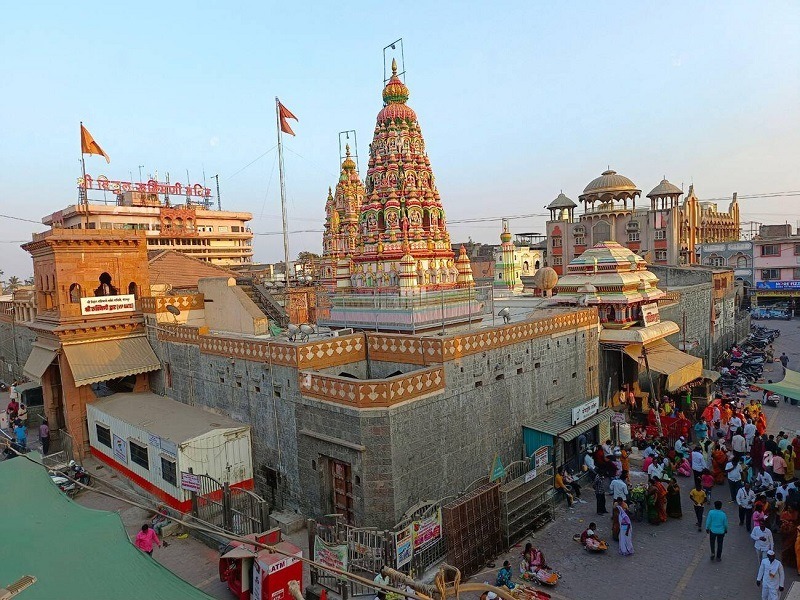Sri Vitthal Rukmini Mandir - History, Timings & Entry Fee
![]() Pilgrimage
Pilgrimage
 #1 of 6 Places to Visit in Pandharpur
#1 of 6 Places to Visit in Pandharpur
 Distance (From Pandharpur): 2 Kms
Distance (From Pandharpur): 2 Kms
 Trip Duration (Including Travel): 1 Hour
Trip Duration (Including Travel): 1 Hour
 Transportation Options: Cab / Auto
Transportation Options: Cab / Auto
 Travel Tips: None
Travel Tips: None
At a distance of 2 km from Pandharpur Railway Station, the Vithoba Temple, officially known as Sri Vitthal Rukmini Mandir is a Hindu temple in Pandharpur, Maharashtra. This is one of the most visited temples in Maharashtra and among the must-include places in Pandharpur tour packages.
Located on the banks of the river Bhima, also known as Chandrabhaga, Vitthal-Rukmini Mandir is dedicated to Lord Vithoba, a form of the Lord Vishnu or Krishna, and his consort Rukhmini. The temple is classified as one among the 108 Abhimana Kshethrams of the Vaishnavate tradition. According to inscriptions dating back to 618 CE, the place was called 'Pandaraga Vittaga' which later got modified into Panduranga Vitthala. The town also became famous as the place of Pundalik (Pundarika Muni), and this is the place where Pundalik took samadhi.
The temple was built by King Vishnuvardhana of the Hoysala Empire between 1108 and 1152 CE. Apparently, Pundalika is assumed to be a historic figure and is said to have convinced Vishnuvardhana who is also known as Bitti Deva to build the temple in Pandharpur. Also, there is an inscription in the temple, of a Hoysala King Vira Someshwara dating back to 1237 CE, which grants the temple a village for its upkeep. An extensive temple was constructed in the second half of the 13th century following the Hemadpanti style of architecture. The temple was attacked by invaders and completely damaged. Only the Namdev gate and a stone slab with an inscription remain from that structure. It is believed that the Vitthal idol was taken to Vijaynagar towards the end of the 15th century and brought back at the beginning of the 16th century.
The present temple was built in the 17th century & later in the Deccan style, with dome motifs and lobed arches by the contribution of Peshwas of Pune, the Shindes of Gwalior, and the Holkars of Indore. The interiors of the temple are extremely beautiful. There is a big quadrangular wooden hall with 'deepmalas' that leads to a square hall called Sola Khambi, which has a beautiful ceiling and 16 pillars. The temple complex accommodates various shrines, halls, cloisters, etc. A standing image of Vithoba is enshrined in the sanctum where all devotees irrespective of caste can enter and place their heads at the feet of Vitthal on rare occasions. There are shrines for Rukmini Devi, Satyabhama Devi, Radhika Devi (Rahi), Lord Narasimha, Lord Venkateshwara, Goddess Mahalakshmi, Nagaraj, Ganesha, and Annapoorna Devi.
The Varkari sect of Maharashtra and the Haridasa sampradaya of Karnataka are the two major sects of the Bhakti movement that have always been associated with the worship of Vitthala. Saints like Dnyaneshwar, Tukaram, Eknath, Namdev, Purandara Dasa, Vijaya Dasa, Jagannatha Dasa all have been known devotees of Vitthala and have popularised the worship of Vitthala in Maharashtra and Karnataka. In 2014, the temple became the first in India to invite women and people from backward classes as priests.
Vitthala Temple attracts thousands of visitors every day and on Ashadi Ekadasi (June- July), a Dindi procession takes place at the temple, which attracts devotees from different parts of the world. A grand palanquin procession is organized at the temple. Besides, Kartiki, Magh, and Chaitra Ekadashis are the other major festivals celebrated with great pomp and fervor.
Timings: 6 AM - 11 AM & 4 PM - 10.30 PM
Entry: Free
















